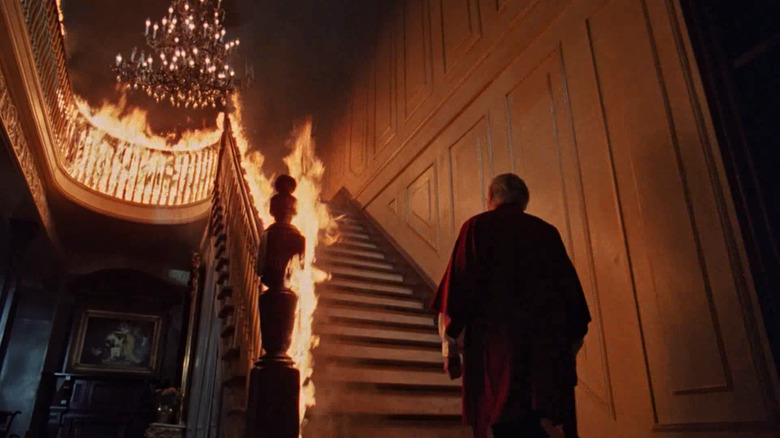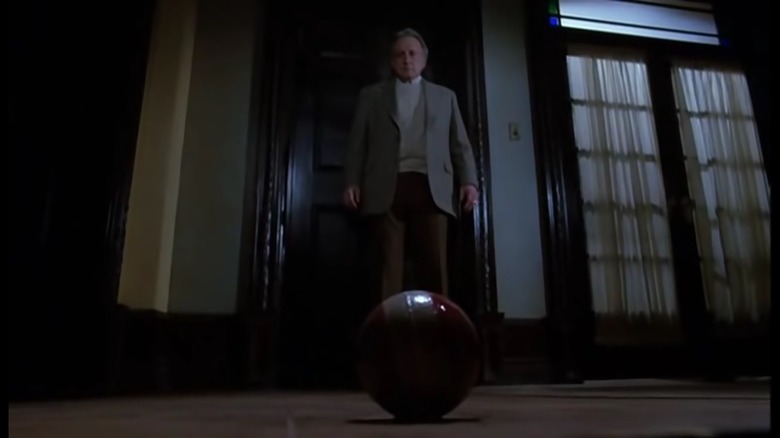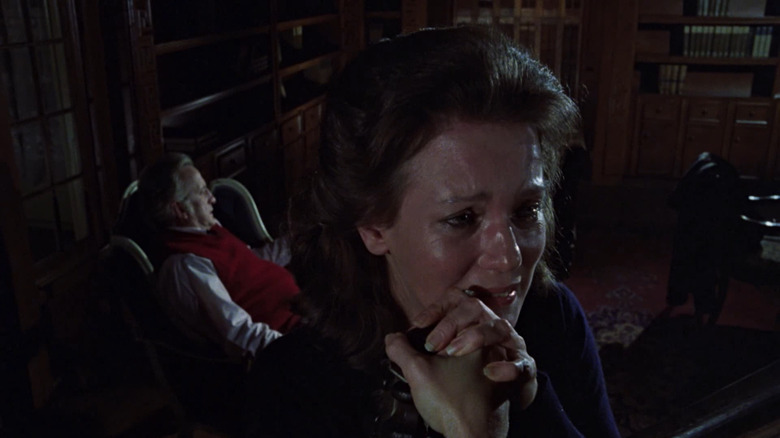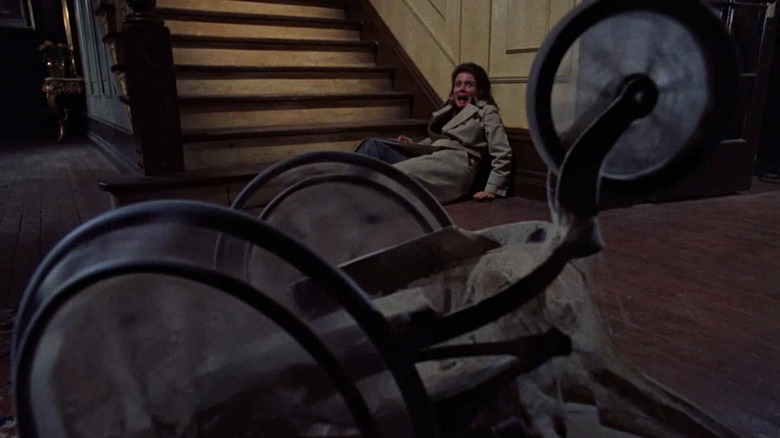One Of The Scariest Scenes In The Changeling Will Send Chills Down Your Spine
(Welcome to Scariest Scene Ever, a column dedicated to the most pulse-pounding moments in horror with your tour guides, horror experts Matt Donato and Ariel Fisher. In this edition: Ariel details a simple yet haunting scene in "The Changeling," while Matt experiences the iconic ghost story for the first time.)
Along with movies like "Jaws" and "Ghost Story," "The Changeling" was a part of my family's regular horror rotation. I've been watching it since I was probably about seven or eight years old, and it's been a favorite of mine ever since. Now, however, as I've gotten older, the terrifying aspects of the film have shifted, like moving goalposts. Where Trish Van Devere being chased down the stairs by Joseph's wheelchair gave me nightmares for weeks as a child, now it's the subtler things that chill me to the bone.
Though it's critically lauded, "The Changeling" is, unfortunately (and surprisingly), not a very popular horror movie. It's been getting a bit of a mainstream moment in the sun over the last few years, especially after Severin's Blu-ray release in 2018. "The Changeling" had a massive impact on filmmakers like Martin Scorsese and Guillermo Del Toro (who famously hugged director Peter Medak, thanking him profusely for making the movie), and we owe it a debt of gratitude for inspiring some of the most memorable horror moments of the last 39 years. Without "The Changeling," we wouldn't have "The Ring," a great deal of the "Conjuring" universe, the séance in "Insidious," key Tangina scenes in "Poltergeist," and the tone or even characters from Alejandro Amenábar's "The Others." And this just scratches the surface of its influence.
So what is the scariest scene in the movie? The truth is that there are several. Whether you're looking for the Dread Scare™ of a grieving man watching the murder of a child, the classic aforementioned jump scare with Van Devere, or something a bit more subtle, it earns every fright. For me, though, the most terrifying part of the film comes immediately following the séance.
The Setup
"The Changeling" follows composer John Russell (played by a nuanced and profound George C. Scott) after the devastatingly tragic death of his wife and daughter. Surviving in his solitary grief, he leaves New York to take a teaching job at a university in Seattle. With the help of an agent from the local historical society, Claire Norman (Van DeVere, Scott's wife in real life), he rents an enormous Victorian mansion. After moving in, strange things start to happen: doors opening on their own, strange noises at odd hours, sentimental objects where they shouldn't be. Someone's trying to connect with John, but the key is to find out what they want.
The Story So Far
After moving into the house, which has apparently been vacant for 12 years, strange things start happening. In the middle of playing piano, a key sporadically decides to ... stop working. Until John has left the bench, when it compresses all on its own, reverberating the lost note throughout the massive house. He's woken from a dead sleep at 6:00 a.m. sharp by the sound of forceful clanging and a vague whirring. Doors begin to open on their own as he's composing, alone in the house.
He writes a lullaby, or so he thinks he has.
He tries to move on from his grief like it's something to run away from, but it haunts him like whatever's in his house, clanging at 6 o'clock every morning, inexplicably calling out.
One night, after rehearsals, when everyone's gone home, John hears a strange noise coming from the kitchen and finds the faucet running. As soon as he shuts it off, another seems to start flowing upstairs. On and on it goes, as he follows the running faucets up to the top floor where he shuts off the water from a tub. There, he sees the face of a young boy floating under the surface of the water, drowned.
Looking for answers, John goes to Claire, who barely knows more than him.
"That house is not fit to live in," Claire's colleague Minnie Huxley (Ruth Springford) tells him. "No one's been able to live in it. It doesn't want people."
Eventually, he's led upstairs to find a hidden attic room tucked away behind a set of shelves in a seemingly forgotten closet. There he finds the remnants of a child's room, long forgotten, covered in cobwebs and dust. He also finds a music box that happens to play the song he thought he'd just written.
The startling coincidence leads John and Claire to believe that something — someone — is calling out to him.
A truly haunting occurrence with his deceased daughter's toy ball leads him to seek help through unconventional channels.
The Scene
After reaching out to the university's department of Psychic Research (yes, actually), a medium, Leah Harmon (Helen Burns), comes to the house to oversee a seance and try communicating with the spirit. As soon as Leah enters the house, she's immediately drawn upstairs, directly to the attic room that was once left forgotten.
Leah enters a trance, aimlessly scribbling on blank pieces of paper, waiting to be spoken through.
It's a little boy. His name is Joseph. And he's desperately calling out to John for help.
The séance abruptly ends with the shattering of glass, as Joseph presumably retreats back to his room. Once everyone has left, John plays back the recording from the evening, only now there's another voice on the track.
It's that of a young boy, calling out breathlessly, whispering his own name. Incredulous, John plays the tape back repeatedly, steadily turning the volume up each time. We watch as John's face falls in horror as Joseph responds "My father" to the question "how did you die?" He enters a kind of trance, as Joseph tears him into the past, and shows John exactly how he died; drowned in the tub by his own father.
The ghost of a child murdered by his own father, desperately reaching out to a father who'd just lost his daughter. Desperate to be saved, for the pain to end, to be comforted.
Flushed and sick following the ordeal, John manages to make his way to the phone and calls Claire to come back. He collapses, drained from the experience, both physically and mentally.
As Joseph's voice echoes through the halls of the immense and empty home, it's made clear that Claire is listening to the tapes. Distraught upon finishing them, she rejoins John as he starts to work through what must have happened.
"The child, Joseph Carmichael ... he was murdered in this house, in the attic ... and buried ... and then an orphan..."
It's too much for Claire to think about, too horrific. She screams at him to stop as she walks into the hallway, begging him to stop "just for one minute, please!" As she glances up the stairs, she freezes, her eyes going immediately wide, a horrified gasp of air rasping into her lungs. She's still as a statue, almost afraid to move. John, curious, walks towards her.
There, inexplicably at the top of the stairs, covered in cobwebs, is Joseph Carmichael's wheelchair, knowingly creaking back and forth.
The Impact (Matt's Take)
It's such a simple visual, bringing with it the weight of previous discoveries and antique rot. I think that's what makes "The Changeling" so unsettling. These aren't especially extreme scare tactics — a ball, a drowning boy, a dusty wheelchair. And yet, the sight of a discarded mobility aid tethers to the atrocities John connects with on a supernatural level, enhanced by his trauma and spiraling sanity. He's chased by pain and anguish, as represented via the wheeling helper.
My preparatory watch of "The Changing" was a first, although I've seen the iconic haunts Ariel points out above. It's impossible to watch a YouTube clip or a documentary where talking heads recall iconic scares throughout horror history without a mention of "The Changeling." It's almost like I entered with familiarity, but that robbed me of none of the shock or awe throughout the paranormal ordeal. There's something so enduring about the film's emotional core and malicious intent that ages without any blemish, so understanding in the basest concepts of fear. Death lurks in physical residences and subconscious recesses, both of which are exploited in tandem. The sight of the wheelchair marries these elements in a single frame.
I get more of a rise out of the wheelchair chase as it races around banister curves and hallways without a visible driver, but acknowledge this ominous glimpse as an act of pure terror. Hearing whispers on a recording is one thing. Seeing images of a horrible murder is another. Both exist as remembrances that can be pushed from consciousness — but not an object that moves independently. The wheelchair is a symbol of dread, confirming John's anything but alone in his new estate. A constant reminder that promotes only unrest.



